Review: Soulpepper’s enthralling Mother’s Daughter examines how power can corrupt the soul
- Joshua Chong

- Jan 26, 2020
- 3 min read
Updated: Mar 17, 2020
Starring: Shannon Taylor, Jessica B. Hill, Fiona Byrne, Andrea Rankin
Director: Alan Dilworth
Playwright: Kate Hennig
Venue: Baillie Theatre
Run Information: Mother’s Daughter is currently running through February 9, 2020.
Rating: ★★★★
This half historical, half psychological drama stars the captivating Shannon Taylor.

It’s ‘Benevolent Mary’, not ‘Bloody Mary’. At least that is how it goes in Soulpepper’s sizzling production of Mother’s Daughter, a quasi-historical drama that details the rise of England’s first female monarch, Mary I.
As the third and final play of Kate Hennig’s Queenmaker Trilogy, Mother’s Daughter begins as the Tudor throne is empty, following the death of Edward VI. Mary (Shannon Taylor), the eldest child of Henry VIII, is pushed by her advisors Bassett (Beryl Bain), Susan (Maria Vacratsis), and Simon (Gordon Patrick White) to claim her rightful seat at the throne by toppling Jane (Amanda Rankin), her cousin and the illegitimate monarch.
But Hennig presents a Mary who has far different intentions: a woman who seeks peace and stability instead of war and chaos. Rather than the one-dimensional descriptions of ‘Bloody Mary’ in the history books, — a Mary who burned hundreds of Protestant heretics at the stake — the Mary in Hennig’s play is a more nuanced character, who grapples with the external pressure thrust upon her, along with her own values. And in a thrilling — albeit overused — coup de théâtre early in the play, Hennig introduces the character of Catalina (Fiona Byrne), Mary’s mother, as a ghost in her daughter’s mind, continually taunting and harassing her daughter to carry out her wish: kill Mary’s half-sister Bess (Jessica B. Hill) and cement her daughter’s grasp on the throne.
Of course Catalina, played with unrelenting intensity by Byrne, is just a figment of her daughter’s imagination, an apparition containing Mary’s deepest desires. This makes the play more of a psychological drama than a historical one. We see Mary’s struggle with the decision to assassinate Jane, performed with convincing naivety by Rankin, for she knows that her 16-year-old cousin is merely a pawn who was forced upon the throne. But perhaps the more interesting dynamic is between Mary and Bess. Hill’s Bess is outgoing and brass, the antithesis of Mary, who behind closed doors is shrouded with self-doubt. Despite their differences, however, Hennig’s particularly moving epilogue shows that there has always been love and mutual respect between the sisters.
As Mary, Taylor delivers a powerful and grounded performance, depicting the different facades of a woman who is at odds with herself and the world around her. Bain, Vacratsis, and White are a perfect trio as Mary’s zealous advisors, providing some much-needed humour throughout the play.
In Dilworth’s production, — a remount of the Stratford Festival’s production last season — there is never a lull in the proceedings. The dialogue is paced at breakneck speeds, with actors shooting lines one after the other. It effectively highlights the chaotic world that Mary is in, but I wish Dilworth would provide some moments when the play — and audience — can breathe.
Lorenzo Savoini’s two-tiered set, comprised of striking LED lighting design by Kimberly Purtell and an ominous cross hanging at the top of the stage, is used to great effect. The lights pulse, beat, and flicker, as if they are a visual representation of Mary’s veins. As her power begins to corrupt her heart, we see the lights turn from milk white to a blood red.
Dilworth’s decision to set the piece in contemporary dress (simply yet elegantly designed by Savoini) fits perfectly with Hennig’s searing modern dialogue. Mary could very well be any female leader today, trying to survive in a male-dominated world.
Hennig, however, by no means tries to push this as a feminist tale. Mary is neither a hero nor a villain, but a flawed human. She was no worse nor better than the dozens of brutal male monarchs who came before and after her. Yet, because she was a woman, history has painted her actions as bloody and brutish. As Mary says late in the play, “it’s a double standard”. Mother’s Daughter shines another light on her story.







Comments